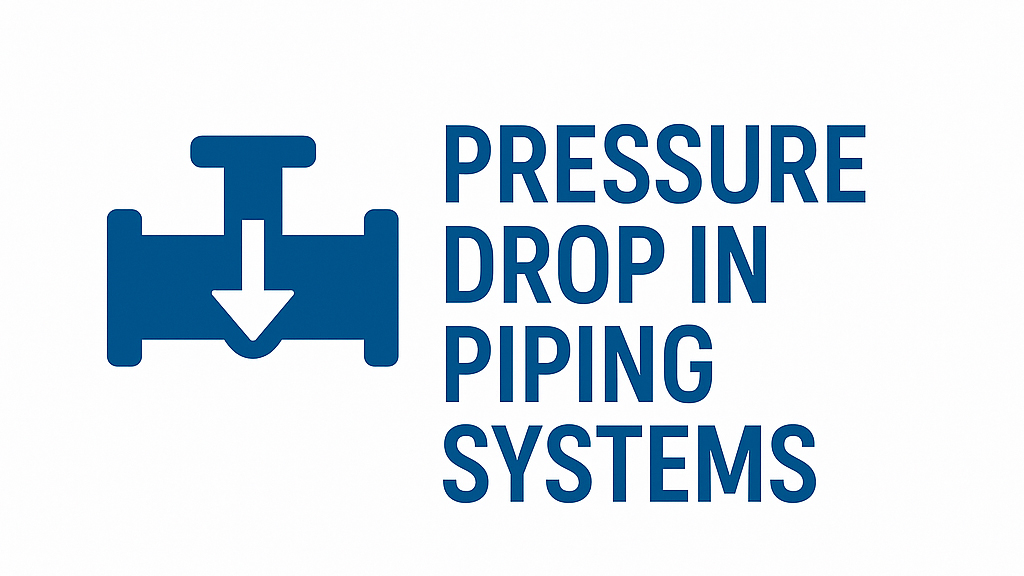Pressure drop in piping systems
Understanding and Managing Flow Resistance
What is Pressure Drop and Why Does It Matter?
Pressure drop, also known as head loss, is the reduction in fluid pressure that occurs as fluid flows through a pipe or system from one point to another. It’s a critical parameter in the design and operation of any piping system because it directly impacts flow rates, energy consumption (e.g., pump sizing), and overall system efficiency. Understanding and accurately calculating pressure drop is essential for proper system design, equipment selection, and operational performance.
Primary Causes of Pressure Drop
Pressure loss in pipes is primarily due to several factors:
Frictional Losses (Major Losses)
Caused by the friction between the fluid and the pipe wall. This is continuous along the length of the pipe and depends on fluid viscosity, pipe roughness, pipe diameter, and flow velocity.
Minor Losses (Fittings & Valves)
Caused by turbulence and changes in flow direction or velocity due to components like elbows, tees, valves, reducers, and entrances/exits. Despite the name, these can be significant in complex systems.
Elevation Changes (Static Head)
Pressure changes due to differences in elevation. Pumping fluid uphill requires overcoming gravity, resulting in a pressure loss (or gain if flowing downhill).
Changes in Flow Velocity
Acceleration or deceleration of the fluid (e.g., in diffusers or nozzles) results in pressure changes according to Bernoulli’s principle.
Key Factors Influencing Pressure Drop
Fluid Properties
- Viscosity (μ): Higher viscosity fluids experience greater frictional losses.
- Density (ρ): Affects kinetic energy and gravitational effects.
Pipe Characteristics
- Diameter (D): Smaller diameter pipes have significantly higher pressure drop for the same flow rate.
- Length (L): Longer pipes result in greater frictional losses.
- Roughness (ε): Rougher internal pipe surfaces increase friction.
Flow Conditions
- Flow Rate (Q) / Velocity (V): Pressure drop increases approximately with the square of the velocity.
- Flow Regime (Reynolds Number, Re): Laminar flow generally has lower friction than turbulent flow.
System Components
- Fittings & Valves: Each component introduces a “minor loss” characterized by a loss coefficient (K-factor) or equivalent length.
Calculating Pressure Drop (Conceptual Overview)
Accurate calculation is key for system design. Common approaches include:
Darcy-Weisbach Equation
A fundamental and widely applicable equation for calculating frictional head loss in pipes for both laminar and turbulent flow. Requires a friction factor (f), often determined using the Moody diagram or Colebrook equation.
ΔP = f * (L/D) * (ρV²/2)
Hazen-Williams Equation
An empirical formula commonly used for water flow in pressurized systems, particularly in civil engineering applications. Simpler to use as it relies on a “C” factor representing pipe roughness.
Moody Diagram / Colebrook Equation
Used to determine the Darcy friction factor (f) based on the Reynolds number (Re) and relative pipe roughness (ε/D).
Minor Losses Calculation
Calculated using K-factors (loss coefficients specific to each fitting/valve) or equivalent length methods: ΔPminor = K * (ρV²/2)
Software Tools
Numerous software packages (e.g., AFT Fathom, Pipe-Flo, Aspen HYSYS Hydraulics) perform complex pressure drop calculations for entire networks, incorporating all factors.
Illustrative Sources of Pressure Drop in a System
This chart shows a hypothetical breakdown of where pressure losses might occur in a typical piping system. Actual distribution varies greatly.
Consequences of Excessive Pressure Drop
- Reduced Flow Rates: Insufficient pressure to deliver the required fluid quantity.
- Increased Energy Consumption: Pumps or compressors must work harder, leading to higher operational costs.
- Oversized Equipment: May necessitate larger, more expensive pumps or compressors.
- Poor Equipment Performance: Some equipment (e.g., spray nozzles, heat exchangers) may not function correctly with low inlet pressure.
- Potential for Cavitation: In pump suction lines if pressure drops below vapor pressure.
- System Inefficiency: Overall reduced performance and higher operating expenses.
Methods to Minimize Pressure Drop
- Proper Pipe Sizing: Select larger diameter pipes (within economic limits) to reduce velocity.
- Smooth Pipe Materials: Use pipes with lower internal roughness (e.g., plastic, smooth stainless steel).
- Minimize Pipe Length: Optimize the piping layout to reduce the overall length.
- Reduce Fittings and Bends: Use fewer elbows, tees, and valves. Opt for long-radius bends over short-radius ones.
- Select Low-Loss Valves: Choose valve types with lower K-factors for on/off service (e.g., full-port ball or gate valves over globe valves if throttling isn’t needed).
- Optimal Layout: Avoid sudden expansions or contractions in pipe diameter.
- Regular Maintenance: Clean pipes to prevent scaling or fouling that increases roughness.
Balancing Flow and Efficiency
Managing pressure drop is a fundamental aspect of efficient and effective piping system design. While some pressure loss is inevitable, understanding its causes and influencing factors allows engineers to design systems that meet performance requirements without excessive energy consumption or oversized equipment. Careful calculations, component selection, and layout optimization are key to creating robust and economical piping networks.

